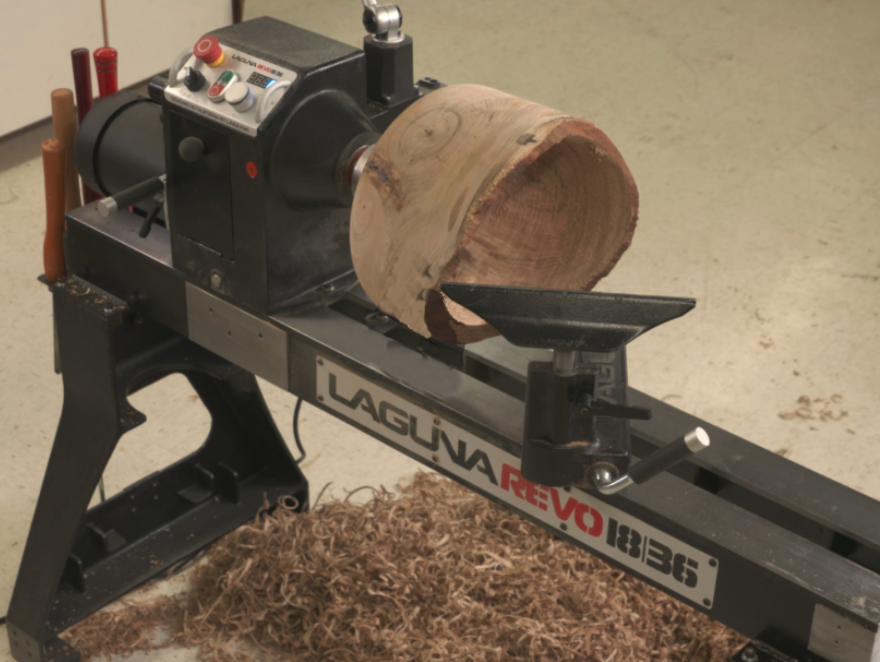Bowl turning is fun and, here’s a warning, very addictive. Here are some tips that’ll help you turn a large natural edge bowl on your lathe. Check out this video for complete how-to.

Start your bowl at the bandsaw and cut the blank as close to round as possible. It doesn’t have to be perfect. A good, heavy lathe will help dampen vibration that results from a blank being out of round. But get it as close to round as you can.

This bowl blank is mounted on a four jaw chuck and pushed against the lathe’s live center. Even though chucks are capable of holding bowls on their own, large bowl blanks like this one benefit from the “insurance policy” of being mounted between centers. Keep the tail center in place as long as you can. What will be the top of the finished bowl is closest to the headstock. After the bowl is shaped and accommodation is made for the chuck, the blank will be turned end for end, hollowed and finished.

Set the height of the tool rest slightly below center (when using the scraping technique) and position it as close to the blank as you can. Be sure to turn the bowl by hand, checking for high spots, to make sure the blank doesn’t hit the tool rest.

For small bowls that are less irregular than this one you can use this speed chart to set the RPM of your lathe. Note that you need to make adjustments to the speed based on what turning step you’re on, roughing, shaping or sanding/finishing.

For large, irregular bowls you can set the speed on the fly. Set the lathe RPM by starting with the speed dial at 0. Power up the lathe and slowly increase the speed while monitoring the bowl. At some point the bowl and lathe will start to vibrate. Set the speed just below that point, while not exceeding the speed/size relationship shown in the chart above.

Start rounding your bowl! When using the scraping technique keep the chisel parallel to the floor. The tip of the chisel should be on the centerline of the bowl. A round-tipped carbide lathe chisel works great for this roughing step.

Stop frequently and adjust the position of the tool rest. It should never be more than ½” from the bowl. You’ll need to continuously adjust the position of the tool rest as you reduce the bowl’s diameter.

Once the bowl is round start shaping the bottom of the bowl.

As you shape the bowl bottom make a recess for the chuck. Check the size of your chuck’s jaws to determine how large and deep the recess should be. Sand the bowl exterior after the outside shape and recess are complete. When sanding is complete cut away the pillar that the live center is mounted to and turn the blank end for end on the lathe, securing the jaws of the chuck in the recess.

Here’s a GREAT benefit of a lathe that includes reverse. When hollowing the interior run the lathe in reverse and cut on the side of the bowl that’s away from you. It’s much easier to see your work, and you won’t have to bend over the bed of the lathe. Be sure to lock the set screw on your chuck onto the lathe spindle so it doesn’t unscrew when you’re cutting in reverse. If your chuck doesn’t have a locking set screw for this purpose, don’t run your lathe in reverse.

Continue shaping and hollowing the bowl interior until you achieve the wall thickness you want. Then sand the interior.
When working with green (wet) wood like this butternut bowl blank there are a number of approaches you can take. Some turners only rough out the bowl, leaving the walls thick. A good rule of thumb is for wall thickness to be 10% the diameter of the bowl. Put the bowl in a brown paper bag, along with some shavings, and give it a few months to dry. Then mount it back on the lathe, turn it to its final shape, sand and finish it.
Other turners treat their green bowls chemically with products like Pentacryl. Pentacryl soaks into the wood, stabilizing the wood cells, so they can’t shrink and cause cracking as the wood dries.

With final sanding and a coat of finish, this butternut bowl will look great!




